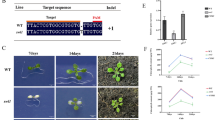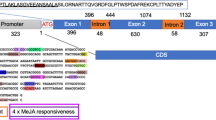Abstract
Cell cultures of Corydalis sempervirens, tolerant to the herbicide glyphosate, have a 30–40-fold increased level of the herbicide's target enzyme 5-enolpyruvylshikimate 3-phosphate (EPSP) synthase, a ten-fold enhanced level of the corresponding mRNA but no amplification of the gene (Holländer-Czytko et al., Plant Mol Biol 11 (1988) 215–220). The increase at the transcriptional level is due to a higher rate of transcription of the gene, which was observed in run-off transcription assays with isolated nuclei. The further amplification at the protein level is the result of stabilization of the enzyme by the herbicide. In the presence of glyphosate the half-life of EPSP synthase was doubled leading to higher levels of both protein and enzyme activity. Overproduction of the enzyme in adapted cultures is stable at the transcriptional level, as cells from adapted cultures grown in the absence of glyphosate for three years still display an about ten-fold higher enzyme activity and transcript level than non-adapted cultures.
Similar content being viewed by others
References
Amrhein N, Johänning D, Schab J, Schulz A: Biochemical basis for glyphosate-tolerance in a bacterium and a plant tissue culture. FEBS Lett 157: 191–196 (1983).
Amrhein N, Holländer H: Light promotes the production of shikimic acid in buckwheat. Naturwissenschaften 68: 43 (1981).
Amrhein N, Holländer-Czytko H, Johänning D, Schulz A, Smart CC, Steinrücken HC: Overproduction of 5-enolpyruvylshikimate 3-phosphate synthase in glyphosate-tolerant plant cell cultures. In: Green C, Somers DA, Hackett WD, Biesboer DD (eds) Plant Tissue and Cell Culture, pp. 119–133 Alan R. Liss, New York (1987).
Boocock MR, Coggins JR: Kinetics of 5-enolpyruvylshikimate 3-phosphate synthase inhibition by glyphosate. FEBS Lett 154: 127–133 (1983).
Bradford MM: A rapid and sensitive method for the quantification of microgram quantities of protein utilizing the principle of protein-dye binding. Anal Biochem 72: 248–254 (1976).
Chappell J, Hahlbrock K: Salt effects on total and gene-specific in vitro transcriptional activity of isolated plant nuclei. Plant Cell Rep 5: 398–402 (1986).
Comai L, Sen LC, Stalker DM: An altered aroA gene product confers resistance to the herbicide glyphosate. Science 221: 370–371 (1983).
Cresswell RC, Fowler MW, Scragg AH: Glyphosate-tolerance in Catharanthus roseus. Plant Sci 54: 55–63 (1988).
Goldsbrough PM, Hatch EM, Huang B, Kosinski WG, Dyer WE, Herrmann KM, Weller SC: Gene amplification in glyphosate tolerant tobacco cells. Plant Sci 72: 53–62 (1990).
Hamilton JW, Bement WJ, Sinclair PR, Sinclair JF, Alcedo JA, Wetterhahn KE: Heme regulates hepatic 5-aminolevulinate synthase mRNA expression by decreasing mRNA half-life and not by altering its rate of transcription. Arch Biochem Biophys 289: 387–392 (1991).
Hauptman RM, della-Cioppa G, Smith AG, Kishore GM, Widholm JM: Expression of glyphosate resistance in carrot somatic hybrid cells through the transfer of an amplified 5-enolpyruvyl-shikimic acid-3-phosphate synthase gene. Mol Gen Genet 211: 357–363 (1988).
Holländer-Czytko H, Amrhein N: 5-enolpyruvylshikimate 3-phosphate synthase, the target enzyme of the herbicide glyphosate, is synthesized as a precursor in a higher plant. Plant Physiol 83: 229–231 (1987).
Holländer-Czytko H, Johänning D, Meyer HE, Amrhein N: Molecular basis for the overproduction of 5-enolpyruvylshikimate 3-phosphate synthase in a glyphosate-tolerant cell suspension culture of Corydalis sempervirens. Plant Mol Biol 11: 215–220 (1988).
Klee HJ, Muskopf YM, Gasser CS: Cloning of an Arabidopsis thaliana gene encoding 5-enolpyruvylshikimate-3-phosphate synthase: sequence analysis and manipulation to obtain glyphosate-tolerant plants. Mol Gen Genet 210: 437–442 (1987).
Labarca C, Paigen K: A simple, rapid, and sensitive DNA assay procedure. Anal Biochem 102: 344–352 (1980).
Lee Ky, Townsend J, Tepperman J, Black M, Chui CF, Mazur B, Dunsmuir P, Bedbrook J: The molecular basis of sulfonylurea herbicide resistance in tobacco. EMBO J 7: 1241–1248 (1988).
Marzluff WF, Huang RCC: Transcription of RNA in isolated nuclei. In: Hames BD, Higgins SJ (eds) Transcription and Translation, pp. 89–129. Practical Approach Series. IRL Press, Oxford/Washington DC (1984).
Persson L, Oredsson SM, Anehus S, Heby O: Ornithine Decarboxylase inhibitors increase the cellular content of the enzyme: implications for translational regulation. Biochem Biophys Res Commun 131: 239–245 (1985).
Pontecorvi A, Tata JR, Phyillaier M, Robbins J: Selective degradation of mRNA: the role of short-lived proteins in differential destabilization of insulin-induced creatine phosphokinase and myosin heavy chain mRNAs during rat skeletal muscle L6 cell differentiation. EMBO J 7: 1489–1495 (1988).
Reinbothe S, Nelles A, Parthier B: N-(phosphonomethyl) glycine (glyphosate) tolerance in Euglena gracilis acquired by either overproduced or resistant 5-enolpyruvylshikimate 3-phosphate synthase. Eur J Biochem 198: 365–373 (1991).
Rizzo PJ, Pederson K, Cherry JH: Transcription and RNA polymerase stimulatory activity in nuclei isolated from soybean. Plant Sci Lett 12: 133–143 (1978).
Sambrook J, Fritsch EF, Maniatis T: Molecular Cloning: A Laboratory Manual. Cold Spring Harbor Laboratory Press, Cold Spring Harbor, NY (1989).
Schöffl F, Rossol I, Angermüller S: Regulation of the transcription of heat shock genes in nuclei from soybean (Glycine max) seedlings. Plant Cell Envir 10: 113–119 (1987).
Shah DM, Horsch RB, Klee HJ, Kishore GM, Winter JA, Tumer NE, Hironaka CM, Sanders PR, Gasser CS, Aykent SA, Siegel NR, Rogers SG, Fraley RT: Engineering herbicide tolerance in transgenic plants. Science 233: 478–481 (1986).
Shirley BW, Meagher RB: A potential role for RNA turnover in the light regulation of plant gene expression: ribulose-1,5-bisphosphate carboxylase small subunit in soybean. Nucl Acids Res 18: 3377–3385 (1990).
Smart CC, Johänning D, Müller G, Amrhein N: Selective overproduction of 5-enolpyruvylshikimic acid 3-phosphate synthase in a plant cell culture which tolerates high doses of the herbicide glyphosate. J Biol Chem 260: 16338–16346 (1985).
Smith CM, Pratt D, Thompson GA: Increased 5-enolpyruvylshikimic acid 3-phosphate synthase activity in a glyphosate-tolerant variant strain of tomato cells. Plant Cell Rep 5: 298–301 (1986).
Steinrücken HC, Schulz A, Amrhein N, Porter CA, Fraley RT: Overproduction of 5-enolpyruvylshikimate 3-phosphate synthase in a glyphosate-tolerant Petunia hybrida cell line. Arch Biochem Biophys 244: 169–178 (1986).
Steinrücken HC, Amrhein N: The herbicide glyphosate is a potent inhibitor of 5-enolpyruvylshikimic acid 3-phosphate synthase. Biochem Biophys Res Commun 94: 1207–1212 (1980).
Takatsuji H, Mori M, Benfey PN, Ren L, Chua N-H: Characterization of a zinc finger DNA-binding protein expressed specifically in Petunia petals and seedlings. EMBO J 11: 241–249 (1992).
Towbin H, Staehelin T, Gordon J: Electrophoretic transfer of proteins from polyacrylamide gels to nitrocellulose sheets: procedure and some applications. Proc Natl Acad Sci USA 76: 4350–4353 (1979).
Wang Y, Jones JD, Weller SC, Goldsbrough PB: Expression and stability of amplified genes encoding 5-enolpyruvyl-shikimate 3-phosphate synthase in glyphosate-tolerant tobacco cells. Plant Mol Biol 17: 1127–1138 (1991).
Willmitzer L, Wagner KG: The isolation of nuclei from tissue-cultured plant cells. Exp Cell Res 135: 69–77 (1981).
Author information
Authors and Affiliations
Rights and permissions
About this article
Cite this article
Holländer-Czytko, H., Sommer, I. & Amrhein, N. Glyphosate tolerance of cultured Corydalis sempervirens cells is acquired by an increased rate of transcription of 5-enolpyruvylshikimate 3-phosphate synthase as well as by a reduced turnover of the enzyme. Plant Mol Biol 20, 1029–1036 (1992). https://doi.org/10.1007/BF00028890
Received:
Accepted:
Issue Date:
DOI: https://doi.org/10.1007/BF00028890




